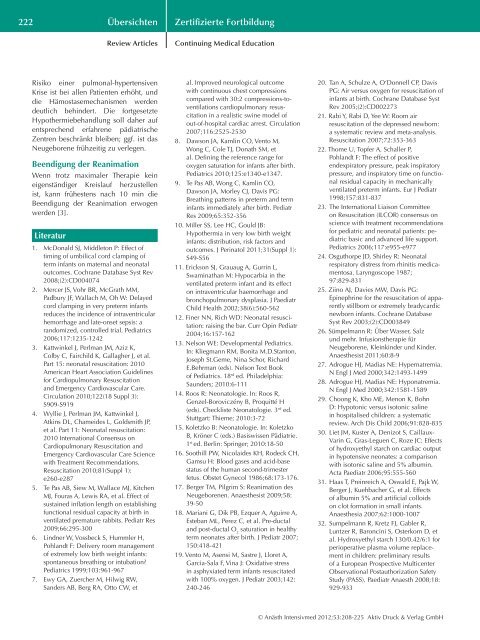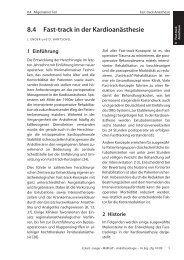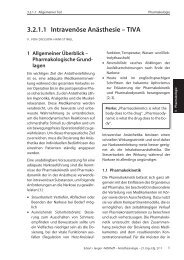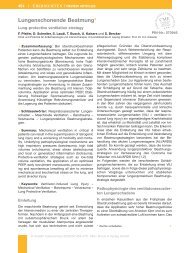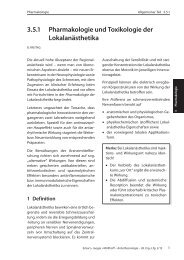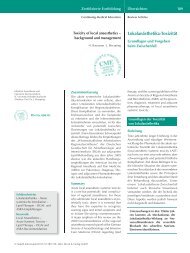Notfälle im Kreißsaal
Notfälle im Kreißsaal
Notfälle im Kreißsaal
Erfolgreiche ePaper selbst erstellen
Machen Sie aus Ihren PDF Publikationen ein blätterbares Flipbook mit unserer einzigartigen Google optimierten e-Paper Software.
222 Übersichten<br />
Risiko einer pulmonal-hyperten si ven<br />
Krise ist bei allen Patienten erhöht, und<br />
die Hämostasemechanismen werden<br />
deutlich be hindert. Die fort ge setzte<br />
Hy po ther miebehandlung soll daher auf<br />
entsprechend erfah rene pädiatrische<br />
Zen tren beschränkt bleiben; ggf. ist das<br />
Neugeborene frühzeitig zu verlegen.<br />
Beendigung der Rean<strong>im</strong>ation<br />
Wenn trotz max<strong>im</strong>aler Therapie kein<br />
eigenstän di ger Kreis lauf herzustellen<br />
ist, kann frü hestens nach 10 min die<br />
Beendigung der Re ani mation er wo gen<br />
werden [3].<br />
Literatur<br />
1. McDonald SJ, Middleton P: Effect of<br />
t<strong>im</strong>ing of umbilical cord clamping of<br />
term infants on maternal and neonatal<br />
outcomes. Cochrane Database Syst Rev<br />
2008;(2):CD004074<br />
2. Mercer JS, Vohr BR, McGrath MM,<br />
Padbury JF, Wallach M, Oh W: Delayed<br />
cord clamping in very preterm infants<br />
reduces the incidence of intraventricular<br />
hemorrhage and late-onset sepsis: a<br />
randomized, controlled trial. Pediatrics<br />
2006;117:1235-1242<br />
3. Kattwinkel J, Perlman JM, Aziz K,<br />
Colby C, Fairchild K, Gallagher J, et al.<br />
Part 15: neonatal resuscitation: 2010<br />
American Heart Association Guidelines<br />
for Cardiopulmonary Resuscitation<br />
and Emergency Cardiovascular Care.<br />
Circulation 2010;122(18 Suppl 3):<br />
S909-S919<br />
4. Wyllie J, Perlman JM, Kattwinkel J,<br />
Atkins DL, Chameides L, Goldsmith JP,<br />
et al. Part 11: Neonatal resuscitation:<br />
2010 International Consensus on<br />
Cardiopulmonary Resuscitation and<br />
Emergency Cardiovascular Care Science<br />
with Treatment Recommendations.<br />
Resuscitation 2010;81(Suppl 1):<br />
e260-e287<br />
5. Te Pas AB, Siew M, Wallace MJ, Kitchen<br />
MJ, Fouras A, Lewis RA, et al. Effect of<br />
sustained inflation length on establishing<br />
functional residual capacity at birth in<br />
ventilated premature rabbits. Pediatr Res<br />
2009;66:295-300<br />
6. Lindner W, Vossbeck S, Hummler H,<br />
Pohlandt F: Delivery room management<br />
of extremely low birth weight infants:<br />
spontaneous breathing or intubation?<br />
Pediatrics 1999;103:961-967<br />
7. Ewy GA, Zuercher M, Hilwig RW,<br />
Sanders AB, Berg RA, Otto CW, et<br />
Zertifizierte Fortbildung<br />
Review Articles Continuing Medical Education<br />
al. Improved neurological outcome<br />
with continuous chest compressions<br />
compared with 30:2 compressions-toventilations<br />
cardiopulmonary resuscitation<br />
in a realistic swine model of<br />
out-of-hospital cardiac arrest. Circulation<br />
2007;116:2525-2530<br />
8. Dawson JA, Kamlin CO, Vento M,<br />
Wong C, Cole TJ, Donath SM, et<br />
al. Defining the reference range for<br />
oxygen saturation for infants after birth.<br />
Pediatrics 2010;125:e1340-e1347.<br />
9. Te Pas AB, Wong C, Kamlin CO,<br />
Dawson JA, Morley CJ, Davis PG:<br />
Breathing patterns in preterm and term<br />
infants <strong>im</strong>mediately after birth. Pediatr<br />
Res 2009;65:352-356<br />
10. Miller SS, Lee HC, Gould JB:<br />
Hypothermia in very low birth weight<br />
infants: distribution, risk factors and<br />
outcomes. J Perinatol 2011;31(Suppl 1):<br />
S49-S56<br />
11. Erickson SJ, Grauaug A, Gurrin L,<br />
Swaminathan M: Hypocarbia in the<br />
ventilated preterm infant and its effect<br />
on intraventricular haemorrhage and<br />
bronchopulmonary dysplasia. J Paediatr<br />
Child Health 2002;38(6):560-562<br />
12. Finer NN, Rich WD: Neonatal resuscitation:<br />
raising the bar. Curr Opin Pediatr<br />
2004;16:157-162<br />
13. Nelson WE: Developmental Pediatrics.<br />
In: Kliegmann RM, Bonita M.D.Stanton,<br />
Joseph St.Geme, Nina Schor, Richard<br />
E.Behrman (eds). Nelson Text Book<br />
of Pediatrics. 18 rd ed. Philadelphia:<br />
Saunders; 2010:6-111<br />
14. Roos R: Neonatologie. In: Roos R,<br />
Genzel-Boroviczény B, Proquitté H<br />
(eds). Checkliste Neonatologie. 3 rd ed.<br />
Stuttgart: Thieme; 2010:3-72<br />
15. Koletzko B: Neonatologie. In: Koletzko<br />
B, Kröner C (eds.) Basiswissen Pädiatrie.<br />
1 st ed. Berlin: Springer; 2010:18-50<br />
16. Soothill PW, Nicolaides KH, Rodeck CH,<br />
Gamsu H: Blood gases and acid-base<br />
status of the human second-tr<strong>im</strong>ester<br />
fetus. Obstet Gynecol 1986;68:173-176.<br />
17. Berger TM, Pilgr<strong>im</strong> S: Rean<strong>im</strong>ation des<br />
Neugeborenen. Anaesthesist 2009;58:<br />
39-50<br />
18. Mariani G, Dik PB, Ezquer A, Aguirre A,<br />
Esteban ML, Perez C, et al. Pre-ductal<br />
and post-ductal O 2 saturation in healthy<br />
term neonates after birth. J Pediatr 2007;<br />
150:418-421<br />
19. Vento M, Asensi M, Sastre J, Lloret A,<br />
Garcia-Sala F, Vina J: Oxidative stress<br />
in asphyxiated term infants resuscitated<br />
with 100% oxygen. J Pediatr 2003;142:<br />
240-246<br />
20. Tan A, Schulze A, O‘Donnell CP, Davis<br />
PG: Air versus oxygen for resuscitation of<br />
infants at birth. Cochrane Database Syst<br />
Rev 2005;(2):CD002273<br />
21. Rabi Y, Rabi D, Yee W: Room air<br />
resuscitation of the depressed newborn:<br />
a systematic review and meta-analysis.<br />
Resuscitation 2007;72:353-363<br />
22. Thome U, Topfer A, Schaller P,<br />
Pohlandt F: The effect of positive<br />
end expiratory pressure, peak inspiratory<br />
pressure, and inspiratory t<strong>im</strong>e on functional<br />
residual capacity in mechanically<br />
ventilated preterm infants. Eur J Pediatr<br />
1998;157:831-837<br />
23. The International Liaison Committee<br />
on Resuscitation (ILCOR) consensus on<br />
science with treatment recommendations<br />
for pediatric and neonatal patients: pediatric<br />
basic and advanced life support.<br />
Pediatrics 2006;117:e955-e977<br />
24. Osguthorpe JD, Shirley R: Neonatal<br />
respiratory distress from rhinitis medicamentosa.<br />
Laryngoscope 1987;<br />
97:829-831<br />
25. Ziino AJ, Davies MW, Davis PG:<br />
Epinephrine for the resuscitation of apparently<br />
stillborn or extremely bradycardic<br />
newborn infants. Cochrane Database<br />
Syst Rev 2003;(2):CD003849<br />
26. Sümpelmann R: Über Wasser, Salz<br />
und mehr. Infusionstherapie für<br />
Neugeborene, Kleinkinder und Kinder.<br />
Anaesthesist 2011;60:8-9<br />
27. Adrogue HJ, Madias NE: Hypernatremia.<br />
N Engl J Med 2000;342:1493-1499<br />
28. Adrogue HJ, Madias NE: Hyponatremia.<br />
N Engl J Med 2000;342:1581-1589<br />
29. Choong K, Kho ME, Menon K, Bohn<br />
D: Hypotonic versus isotonic saline<br />
in hospitalised children: a systematic<br />
review. Arch Dis Child 2006;91:828-835<br />
30. Liet JM, Kuster A, Denizot S, Caillaux-<br />
Varin G, Gras-Leguen C, Roze JC: Effects<br />
of hydroxyethyl starch on cardiac output<br />
in hypotensive neonates: a comparison<br />
with isotonic saline and 5% albumin.<br />
Acta Paediatr 2006;95:555-560<br />
31. Haas T, Preinreich A, Oswald E, Pajk W,<br />
Berger J, Kuehbacher G, et al. Effects<br />
of albumin 5% and artificial colloids<br />
on clot formation in small infants.<br />
Anaesthesia 2007;62:1000-1007<br />
32. Sumpelmann R, Kretz FJ, Gabler R,<br />
Luntzer R, Baroncini S, Osterkorn D, et<br />
al. Hydroxyethyl starch 130/0.42/6:1 for<br />
perioperative plasma volume replacement<br />
in children: prel<strong>im</strong>inary results<br />
of a European Prospective Multicenter<br />
Observational Postauthorization Safety<br />
Study (PASS). Paediatr Anaesth 2008;18:<br />
929-933<br />
© Anästh Intensivmed 2012;53:208-225 Aktiv Druck & Verlag GmbH


